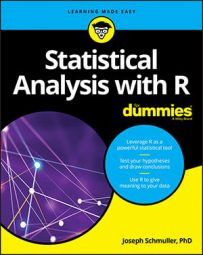Base R statistical functions for central tendency and variability
Here’s a selection of statistical functions having to do with central tendency and variability that come with the standard R installation. You’ll find many others in R packages.
Each of these statistical functions consists of a function name immediately followed by parentheses, such as mean(), and var(). Inside the parentheses are the arguments. In this context, “argument” doesn’t mean “disagreement,” “confrontation,” or anything like that. It’s just the math term for whatever a function operates on.
| Function | What it Calculates | |
mean(x) |
Mean of the numbers in vector x. | |
median(x) |
Median of the numbers in vector x | |
var(x) |
Estimated variance of the population from which the numbers in vector x are sampled | |
sd(x) |
Estimated standard deviation of the population from which the numbers in vector x are sampled | |
scale(x) |
Standard scores (z-scores) for the numbers in vector x | |
Base R Statistical Functions for Relative Standing
Here’s a selection of R statistical functions having to do with relative standing.
| Function | What it Calculates | ||
sort(x) |
The numbers in vector x in increasing order | ||
sort(x)[n] |
The nth smallest number in vector x | ||
rank(x) |
Ranks of the numbers (in increasing order) in vector x | ||
rank(-x) |
Ranks of the numbers (in decreasing order) in vector x | ||
rank(x, ties.method= “average”) |
Ranks of the numbers (in increasing order) in vector x, with tied numbers given the average of the ranks that the ties would have attained | ||
|
Ranks of the numbers (in increasing order) in vector x, with tied numbers given the minimum of the ranks that the ties would have attained | ||
rank(x, ties.method = “max”) |
Ranks of the numbers (in increasing order) in vector x, with tied numbers given the maximum of the ranks that the ties would have attained | ||
quantile(x) |
The 0th, 25th, 50th, 75th, and 100th percentiles (i.e, the quartiles) of the numbers in vector x. (That’s not a misprint: quantile(x) returns the quartiles of x.) |
T-Test Functions for Statistical Analysis with R
Here’s a selection of R statistical functions having to do with t-tests.
| Function | What it Calculates |
t.test(x,mu=n, alternative = “two.sided”) |
Two-tailed t-test that the mean of the numbers in vector x is different from n. |
t.test(x,mu=n, alternative = “greater”) |
One-tailed t-test that the mean of the numbers in vector x is greater than n. |
t.test(x,mu=n, alternative = “less”) |
One-tailed t-test that the mean of the numbers in vector x is less than n. |
t.test(x,y,mu=0, var.equal = TRUE, alternative = “two.sided”) |
Two-tailed t-test that the mean of the numbers in vector x is different from the mean of the numbers in vector y. The variances in the two vectors are assumed to be equal. |
t.test(x,y,mu=0, alternative = “two.sided”, paired = TRUE) |
Two-tailed t-test that the mean of the numbers in vector x is different from the mean of the numbers in vector y. The vectors represent matched samples. |
ANOVA and Regression Analysis Functions for Statistical Analysis with R
Here’s a selection of R statistical functions having to do with Analysis of Variance (ANOVA) and correlation and regression.
When you carry out an ANOVA or a regression analysis, store the analysis in a list. For example,
a <- lm(y~x, data = d)
Then, to see the tabled results, use the summary() function:
summary(a)
| Function | What it Calculates |
aov(y~x, data = d) |
Single-factor ANOVA, with the numbers in vector y as the dependent variable and the elements of vector x as the levels of the independent variable. The data are in data frame d. |
aov(y~x + Error(w/x), data = d) |
Repeated Measures ANOVA, with the numbers in vector y as the dependent variable and the elements in vector x as the levels of an independent variable. Error(w/x) indicates that each element in vector w experiences all the levels of x (i.e., x is a repeated measure). The data are in data frame d. |
aov(y~x*z, data = d) |
Two-factor ANOVA, with the numbers in vector y as the dependent variable and the elements of vectors x and z as the levels of the two independent variables. The data are in data frame d. |
aov(y~x*z + Error(w/z), data = d) |
Mixed ANOVA, with the numbers in vector z as the dependent variable and the elements of vectors x and y as the levels of the two independent variables. Error(w/z) indicates that each element in vector w experiences all the levels of z (i.e., z is a repeated measure). The data are in data frame d. |
| Function | What it Calculates |
cor(x,y) |
Correlation coefficient between the numbers in vector x and the numbers in vector y |
cor.test(x,y) |
Correlation coefficient between the numbers in vector x and the numbers in vector y, along with a t-test of the significance of the correlation coefficient. |
lm(y~x, data = d) |
Linear regression analysis with the numbers in vector y as the dependent variable and the numbers in vector x as the independent variable. Data are in data frame d. |
coefficients(a) |
Slope and intercept of linear regression model a. |
confint(a) |
Confidence intervals of the slope and intercept of linear regression model a |
lm(y~x+z, data = d) |
Multiple regression analysis with the numbers in vector y as the dependent variable and the numbers in vectors x and z as the independent variables. Data are in data frame d. |

